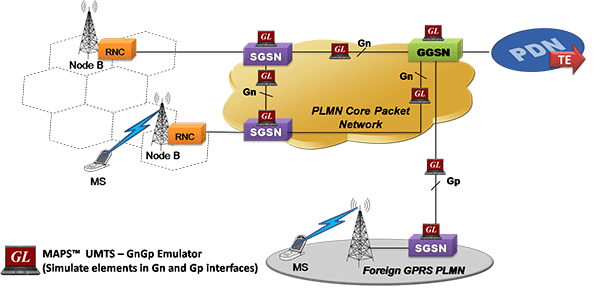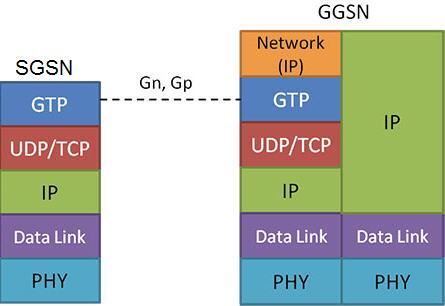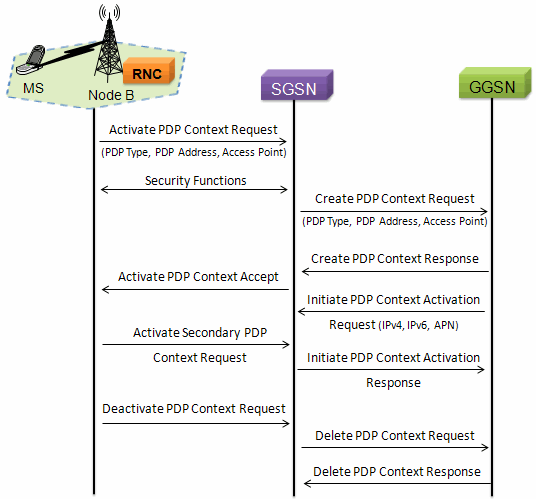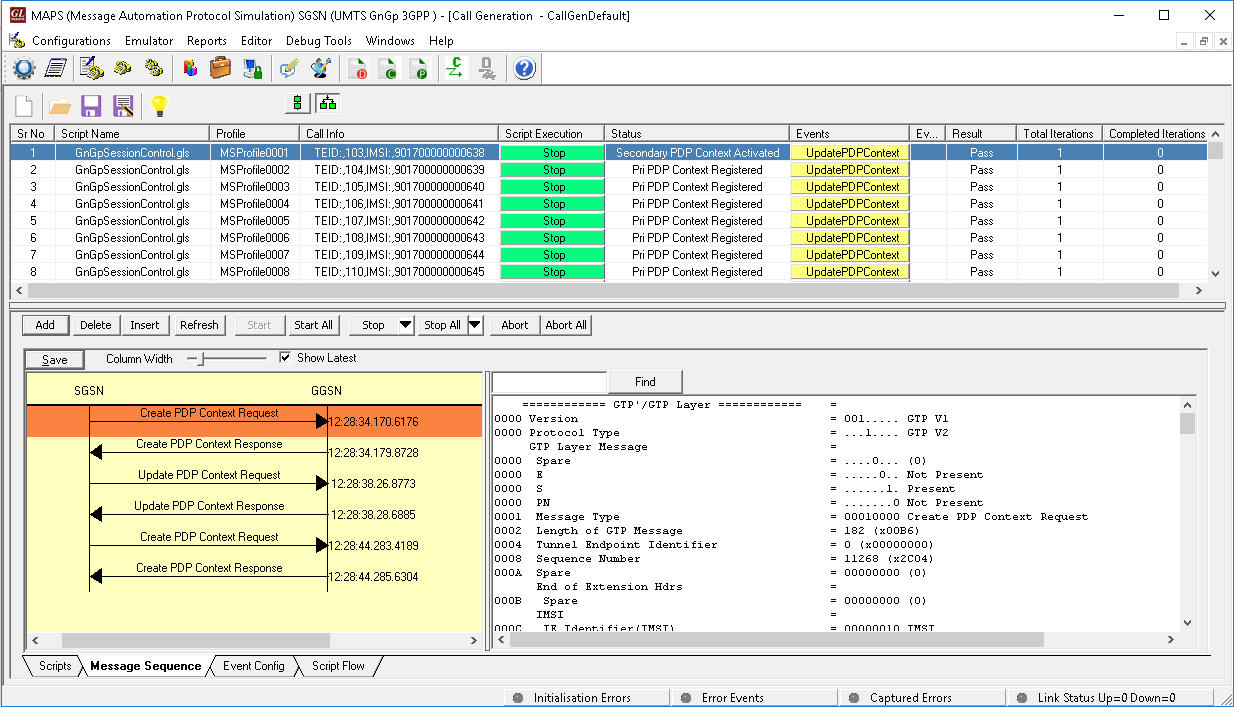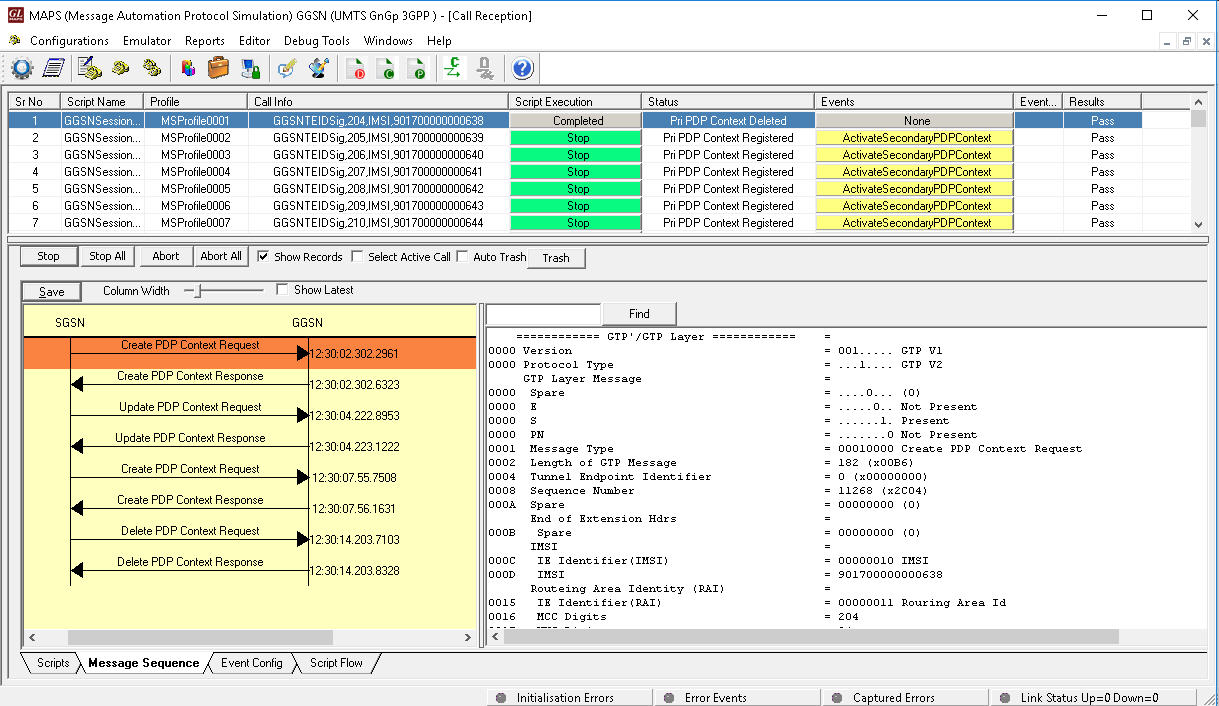MAPS™ Gn Gp Interface Emulator
Simulation UMTS Gn, Gp interfaces between Serving GPRS Support Node (SGSN) and Gateway GPRS Support Node (GGSN) elements supporting high-volume user-plane mobile data (GPRS Tunneling Protocol) traffic.
Brochure Request a QuoteBackground
GPRS and UMTS are evolutions of the Global System for Mobile Communications (GSM) networks. GPRS is a 2.5G mobile communications technology that enables mobile wireless service providers to offer their mobile subscribers with packet-based data services over GSM networks. Common applications of GPRS includes: Internet access, intranet/corporate access, instant messaging, and multimedia messaging. GPRS is standardized by the Third Generation Partnership Program (3GPP).
The GPRS/UMTS packet core is primarily composed of two major network elements:
- Gateway GPRS Support Node (GGSN) — A gateway that provides mobile cell phone users access to a public data network (PDN) or specified private IP network. The GGSN feature provides both the 2.5G GPRS and 3G UMTS GGSN functions.
- Serving GPRS Support Node (SGSN) — connects the Radio Access Network (RAN) to the GPRS/UMTS core and tunnels user sessions to the GGSN. The SGSN sends data to and receives data from mobile stations, and maintains information about the location of a mobile station (MS). The SGSN communicates directly with the MS and the GGSN.
GTP (GPRS Tunneling Protocol) allows multi-protocol packets to be tunneled through the UMTS/GPRS Backbone between GGSN and SGSN.
Overview
GL’s MAPS™ Gn Gp Interface Emulator is an advanced protocol simulator/tester for GTP simulation over Gn, Gp interfaces that can simulate GTP messages and signaling specification as defined in 3GPP TS 29.060 GPRS Tunneling Protocol (GTP) standard. The tester supports testing network elements SGSN and GGSN, error tracking, regression testing, and load testing/call generation. It can run pre-defined test scenarios against GTP interface test objects in a controlled & deterministic manner.
GTP Interface Emulator supports powerful utilities like Message Editor, Script Editor, and Profile Editor which allow new scenarios to be created or existing scenarios to be modified using GTP messages and parameters.
GL’s MAPS™ Gn Gp software benefits Network Equipment Providers of SGSN, and GGSN entities, with -
- Accelerated time to market
- Reduced development costs
- Reduced project risk of internally-developed GTP applications
GL has enhanced the MAPS™ protocol emulation tool to simulate multi-protocol and multi-interface offering a complete range of test solutions, covering the entire 2G, 3G, and 4G network.
By mimicking real-world customer behavior in lab environments, our solutions allow mobile operators and equipment manufacturers to verify their wireless networks before deployment. In other words, one can setup a virtual real-time network simulating all the network elements using “MAPS 3G Wireless Lab Suite”. The test suite supports simulation of IuH, IuCS, IuPS, C/D/Gr/Gd, and GnGp interfaces.
The product supports Mobile traffic core – GTP (ETH101) simulation for user-plane packet transmission and reception services between any two nodes in UMTS networks. Mobile Traffic Core – Gateway (ETH102) module allows simulation of Gateway Traffic to test media gateway telephony interfaces over IP. These modules also support generation and verification of data traffic such as Email, FTP, Web (HTTP), Video, and more.
MAPS™ GnGp Server with PacketLoad appliance supports massive simulation of UEs (up to 500000) with high-volume user-plane mobile data traffic simulation (up to 4 Gbps or 40 Gbps) for both UMTS, and LTE networks.
Main Features
- Setup a virtual real-time network simulating 3G-UMTS network elements using ‘MAPS™ 3G Wireless Lab Suite’
- Simulates SGSN and GGSN.
- Supports GTP Control plane.
- Generates hundreds of Control Signaling (Load Testing).
- Generates and processes GTP messages.
- Supports GTP Traffic (GTP User Plane Data) which includes: verification like BERT testing, HTTP traffic generation capability, GGSN can actually be connected to real IP network to simulate Gateway testing
- High-volume user plane traffic simulation possible with support of Packet Load appliance; both 4Gbps and 40Gbps variants are available to suit customer needs.
- Auto generation feature allows Massive UE simulation for high density load testing.
- Insertion of impairments to create invalid messages.
- Supports customization of call flows and message templates using Script and Message editors.
- Supports scripted call generation and automated call reception.
- Script based & protocol independent software architecture.
- Provides Call Statistics and Events Status.
- Automation, Remote access, and Schedulers to run tests 24/7
Applications
- Provides fault insertion, and erroneous call flows testing capability.
- Functional testing, Regression testing and Conformance testing of network elements.
- Ready scripts makes testing procedure simpler, less time consuming and hence time to market products.
- QoS requests for greater or lesser bandwidth.
- UMTS lab setup can be used in educational institutions for training purposes
Supported Protocols Standards
General MAPS™ Features
- Call Simulation & Control
- Multi-protocol, Multi-interface Simulation
- Script based and protocol independent software architecture
- Auto generate and respond to signaling messages
- Traffic Handling Capabilities (requires additional license)
- Fault Insertion, and Erroneous Call Flows Testing
- Automation
- Pre-processing tools
- Easy script builder for quick testing to advance testing
- Customization of test configuration profiles
- Unlimited ability to customize the protocol fields and call control scenarios
- Centralized Control and Remote Access
- Command Line Interface (requires additional license)
- Option to send reports to database accessible via web interface
- Centralized control of multiple MAPS™ applications remotely from single client application
- Reports and Statistics
- Call Status, Link Status, and Message Statistics
- User defined Statistics for RTP Traffic parameters
- Capture Events, and Error Events
Call Simulation and Control
The signaling and traffic simulation in a call is completely implemented using scripts. Commands in the scripts are executed in controlled way to simulate protocol and traffic behavior. Most of the commands used in the scripts are generic and independent of specific protocol.
MAPS™ application acts as either the Caller or resides at the network terminal acting as Callee. The Call Generation feature simulates an outgoing call by sending call control messages to the DUT using scripts and profiles. The profiles allow necessary parameters of call control messages to be changed during runtime. Call generated from other entity can be automatically detected in call reception window by pre-setting the required answer scripts in the Incoming Call Handler.
The call control scripts can also automatically handle the traffic over the established call. MAPS™ supports transmission and detection of various traffic types over IP (RTP, GTP), ATM, & TDM - such as, digits, voice file, single tone, dual tones, fax, sms, email, http, ftp, IVR, audio and video quality. MAPS™ also includes support for wide range of codec rates – visit traffic-simulation and voice-codecs webpage for more details.
Message Sequence - Each call scenario provides the trace with full decoding of the messages exchanged between the MAPS™ and the DUT, and graphical ladder diagrams of the call flow with time stamp. Impairments can be applied to messages to simulate error conditions that occur in real-time networks.
Event-Driven Control - Scripts execution, being event-based, allows redirection of script execution on-the-go with user-defined events. The custom parameters in the events can also be changed during script execution using event profiles.
Script Contents & Script Flow - The script flow and the contents window displays the Script Name, Sub-script Name, Script line number, and script statements to be successfully executed, which help the users in troubleshooting a particular call scenario.
Bulk Call Simulation and Load Testing
MAPS™ supports automated stress/load testing capabilities through Load Generation and Bulk Call Simulation features. Bulk Call Simulation allows quick configurations to easily create multiple test entries with different scripts and profiles. Multiple tests can be run simultaneously or sequentially (queue up tasks in succession). Load generation feature further allows specifying the patterns with which the bulk calls can be generated. Load generation can be customized with different statistical distribution patterns such as Uniform, Ramp, Sawtooth, Fixed, Normal, Step, and Step-Sawtooth distribution. Call duration also can be randomized using similar statistical distribution. This feature also helps users configure Stress/Load Testing parameters such as Call per second (CPS), Max Active Call, Minimum and Maximum Call Rates, Start Call Rates, and other parameters.
Scheduler
Scheduler can be used to schedule the simulation of bulk calls or manual calls at a specific start time. The pre-saved master configuration files for test setup and call simulation are automatically loaded to automate the test procedure.
Customization of Test Setup Parameters
The test setup profiles (.xml files) allow users to configure the necessary parameters in order to establish communication between MAPS™ and the DUT. It includes configuring parameters of the network nodes, the network properties, and transport related configurations such as T1/E1 timeslots, IP Address and port numbers for both MAPS™ and the DUT.
Once the transport layer is configured properly, protocol specific signaling messages and traffic can be transmitted and received successfully. All parameters setup in test setup are global and are accessible to all scripts. These parameters initialize protocol engines and the transport modules specific to the protocol.
Customization of Test Parameters, Call Flow, and Protocol Messages Using Pre-Processing Tools
- Message Editor - The Message Templates (GL’s proprietary *.HDL files) comprises of protocol encoding parameters with preset values. It is required to create a message template for every message in a protocol. The message templates are called within the scripts to perform scenario based testing.
- Profile Editor – Profiles (*.xml files) are used to change the values of the fields in the messages (i.e. Message Template in MAPS™) during the course of a call. The multiple profiles with varying parameter values that allow users to configure call instances in call generation and to receive calls.
- Script Editor - The script editor allows the user to create / edit scripts and to define variables for the fields in the messages. The script uses pre-defined message templates to build call flow and perform send and receive actions. Script editor provides options to run the test for multiple iterations in sequential or random flow. Commands allow retransmission of messages with specific interval.
Command Line Interface
Supports scripting through a Command Line Interface (CLI) such as the Python, and TCL, using MAPS™ client-server functionality (requires additional license)
MAPS™ can be configured as server-side application, to enable remote controlling of the application through multiple command-line based clients. Supported clients include C++, TCL, Python and others. TCL provides a simple scripting language, with programming facilities such as looping, procedures, and variables. The TCL Client application includes a MapsTclIfc.dll file, a packaged library that enables communication with the Server from a TCL environment.
User can remotely perform all functions such as start test bed setup, load scripts and profiles, apply user events such as send digits/file/tones, detect digits/file/tones, dial, originate call, terminate call, start and stop traffic and so on. User can also generate and receive calls through commands. This client application is distributed along with MAPS™ Server application. Multiple MAPS™ CLI servers can be controlled remotely from single client application (such as TCL, Python, etc).
Call Statistics, Events, Link Status
Call Status & Message Statistics - By default, all call handling scripts (irrespective of the type of the functions) are assessed by MAPS™ to provide statistical information about Total Calls, Active Calls, Completed Calls, Passed Calls, Failed Calls, and Calls/Sec. It is also possible to categorize the statistical information as per the call handling scripts. In addition, Call Generation and Call Reception windows provide useful call status & script execution results.
In addition, Message Stats option for any specific protocol, logs number of times the messages are being transmitted (Tx Count) and received (Rx Count), thus allowing user to monitor the occurring events.
User Defined Statistics - Users can customize the global statistics for RTP audio and video traffic. These global parameters are defined in the call generation scripts, which are calculated and updated periodically on run time.
Events Reporting – MAPS™ provides Event Log, Error Events, and Captured Errors windows that log the captured events and errors encountered during the progress of the call.
Link Status - Link Status window indicates transport related information of the protocol, for example, if SCTP is used as transport, it indicates if the association is Up or Down in the Link Status window. MAPS™ IuCS ATM uses SSCOP transport and the associated link status is indicated as Up or Down in the Link Status window.
Resources
Please Note: The XX in the Item No. refers to the hardware platform, listed at the bottom of the Buyer's Guide, which the software will be running on. Therefore, XX can either be ETA or EEA (Octal/Quad Boards), PTA or PEA (tProbe Units), XUT or XUE (Dual PCIe Express) depending upon the hardware.
| Item No. | Item Description |
| PKS166 | MAPS™ UMTS - Gn Gp Interface Emulation |
| ETH100 ETH101 ETH102 |
Mobile Traffic - PacketCheck™ Mobile Traffic Core - GTP Mobile Traffic Core - Gateway |
| Related Software | |
| PKS140 | MAPS™ LTE S1 Emulator |
| PKS142 | MAPS™ LTE eGTP Emulator |
| PKS164 | MAPS™ UMTS IuPS interface |
| XX165 | T1 or E1 UMTS Protocol Analyzer |
| OLV165 | Offline UMTS Protocol Analyzer |
| LTS206 | OC-3 / STM-1 UMTS Protocol Analysis |
| LTS306 | OC-12 / STM-4 UMTS Protocol Analysis |
| PKS160 PKS102 |
MAPS™ UMTS-IuCS MAPS™ UMTS-IuH RTP Soft Core for RTP Traffic Generation |
| LTS100 | Lightspeed™ - Dual OC-3/12 STM-1/4 PCIe Card |
| LTS105 | Lightspeed™ - Portable Dual OC-3/12 STM-1/4 USB Unit |
| LTS220 | MAPS UMTS IuCS ATM over OC-3 / STM-1, requires LTS214 |
| LTS214 | OC-3 / STM-1 SSCOP Server |
| LTS217 | OC-3 / STM-1 AAL2 Traffic Core |
| LTS320 | MAPS UMTS IuCS ATM over OC-12 / STM-4, requires LTS314 |
| LTS314 | OC-12 / STM-4 SSCOP Server |
| LTS317 | OC-12 / STM-4 AAL2 Traffic Core |
| PKS120 PKS121 PKS122 PKS123 PKS124 PKS130 |
MAPS™ SIP Emulator MAPS™ SIP Conformance Test Suite (Test Scripts) MAPS™ MEGACO Emulator MAPS™ MEGACO Conformance Test Suite (Test Scripts) MAPS™ MGCP Emulator MAPS™ SIGTRAN Emulator |
| PKS120 | MAPS™ SIP Emulator |
| PKV100 | PacketScan™ (Online and Offline) |
| PKB100 | RTP Toolbox™ |
| PKS110 | Packet H.323 |
